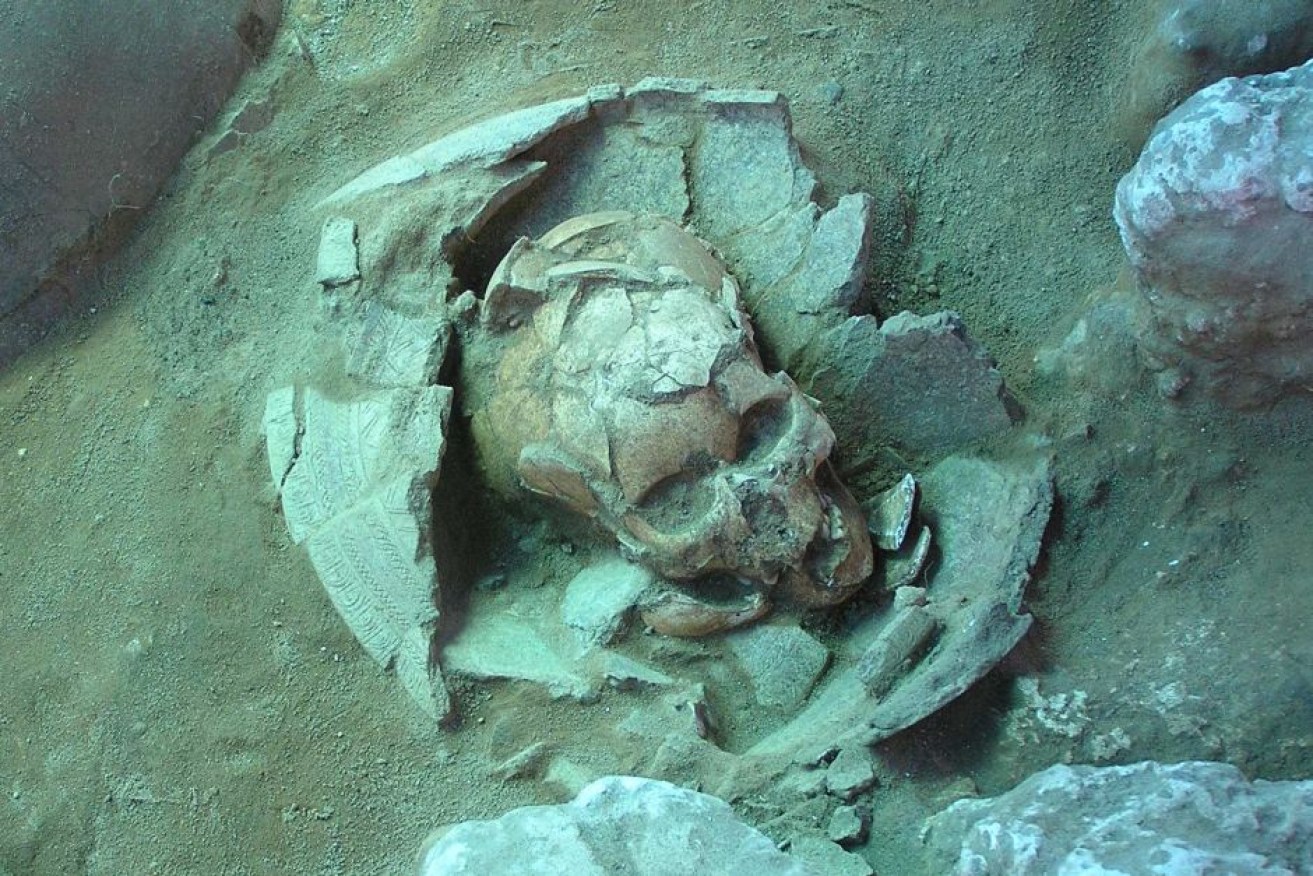DNA reveals Pacific Island ancestors came from Asia

DNA was extracted from this 3,000 year old skull and mandible from Vanuatu. Photo: supplied (Frederique Valentin)
A wealth of archaeological evidence, including intricate pottery, indicates people associated with the Lapita culture were the first to colonise the remote islands in the Pacific in the last major dispersal of people to unpopulated lands 3000 years ago.
But until this analysis we did not know who these people were, the study’s co-author Professor Matthew Spriggs of the Australian National University said.
“Now that we’ve got the DNA of the ancient Lapita people, the big shock is that they are really like [Aboriginal] people from Taiwan,” Professor Spriggs said.

A 3,000 year old burial site in Vanuatu with bones arranged in a triangular pattern. Photo: Supplied (Frederique Valentin)
Today, all South Pacific Islanders have a heritage that includes DNA from both a Papuan and an East Asian population to varying degrees.
The relationship between the Lapita people and Papuan people, which dominated the region for 50,000 years, has been long debated.
Linguistically and culturally the Lapita were similar to Asian groups.
But many archaeologists thought the Lapita mixed with the Papuan population as they travelled down through New Guinea and the Solomon Islands before setting out towards the remote islands 3000 years ago.
To uncover the origins of the Lapita people, Professor Spriggs and his colleague Dr Stuart Bedford worked closely with the Vanuatu Cultural Centre to excavate and extract DNA from skeletons from the Teouma burial ground in Vanuatu.
“This is in fact the fourth attempt to extract ancient DNA over the last decade,” Professor Spriggs said.
Finally, a genetic analysis by a team led by Dr David Reich at Harvard University revealed three skeletons aged between 3,100 years and 2700 years contained no traces of Papuan DNA.
A fourth Lapita skeleton aged between 2,700 and 2,300 years that was excavated in Tonga by a second team, led by Dr Geoffrey Clark of the Australian National University, and analysed at a different lab in Germany, also contained no Papuan DNA.
An additional analysis of DNA volunteered by 778 present-day people from East Asia and Oceania shows all four skeletons contain unique DNA that no longer exists, but is similar to that found in Aboriginal groups from Taiwan and some northern Philippine populations.
“The first people who got to Vanuatu were not these people who’d been in the region for 50,000 years … they were these Asian populations,” Professor Spriggs said.

A loop motif on a shard of Lapita pottery recovered in Tonga. Photo: supplied (David Burley)
The analysis also showed that the Asian genes in today’s Pacific people came from these first remote Oceanians.
“What we’ve been able to say is that Asian inheritance comes from Lapita,” Professor Spriggs said.
He said the finding, reported in the journal Nature, challenged the use of labels such as Melanesian and Polynesian to describe peoples from different parts of the Pacific.
“I’d like to call them Pasifika people because I think these old categories we inherited from the 19th century don’t make much sense biologically or culturally,” he said.
“The variation is simply the percentage of the genetic inheritance from the first people who got out to these islands 3,000 years ago.”
Clues and questions about Pacific ancestry
Commenting on the study, director of the Australian Centre for Ancient DNA Professor Alan Cooper said the paper provided a lot more information about the Pacific and Polynesian origins “that was just conjecture before”.
“It clarifies this whole issue of how you get two groups of people together to form another one that does the most amazing voyages,” Professor Cooper said.
– ABC








